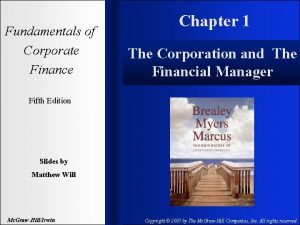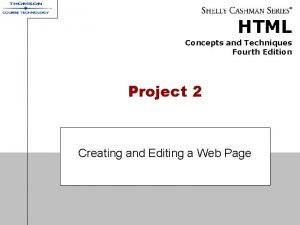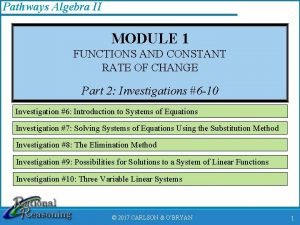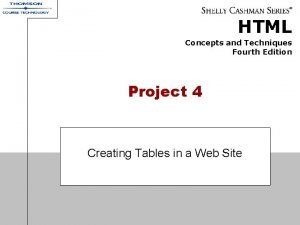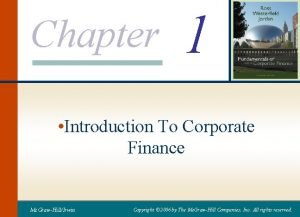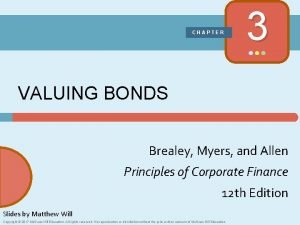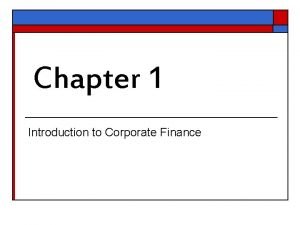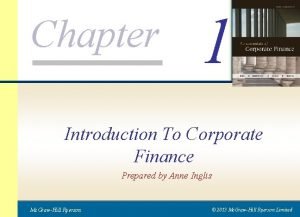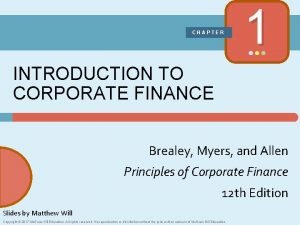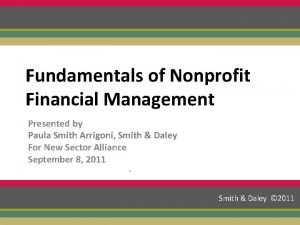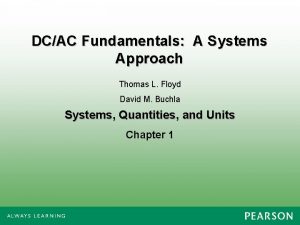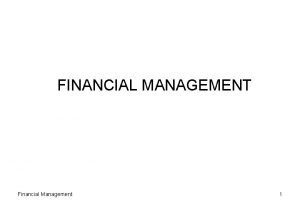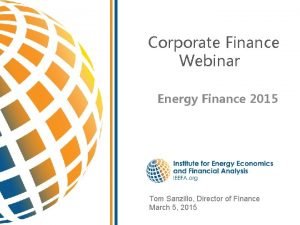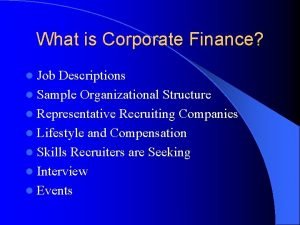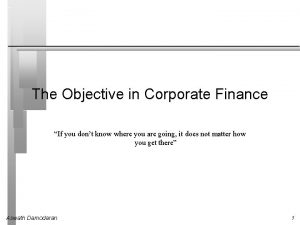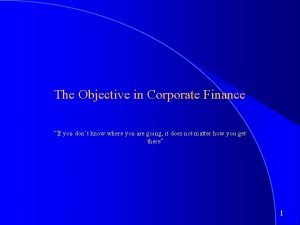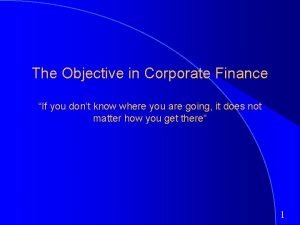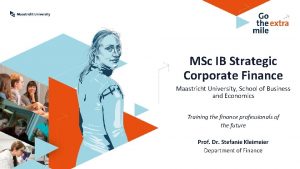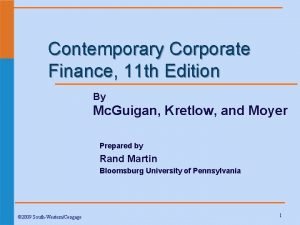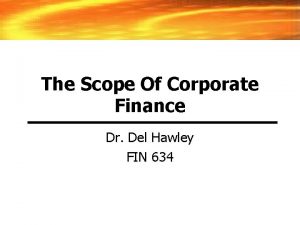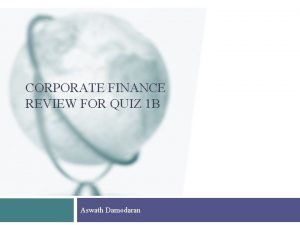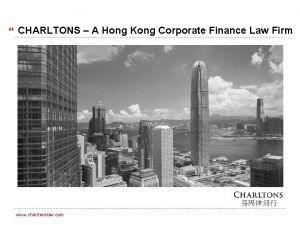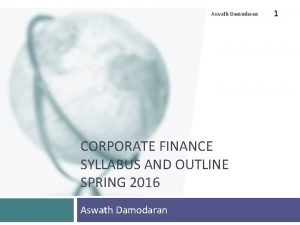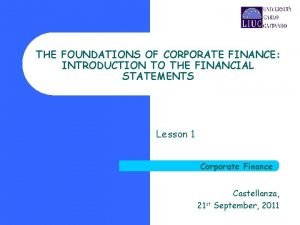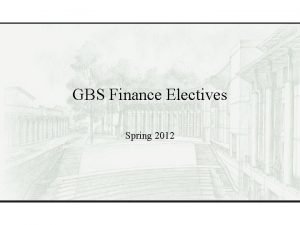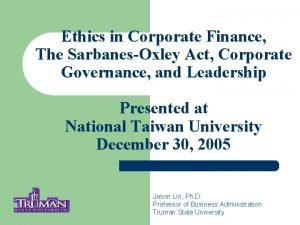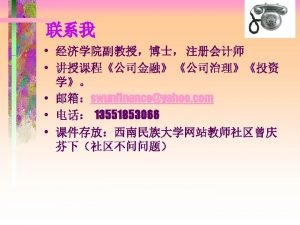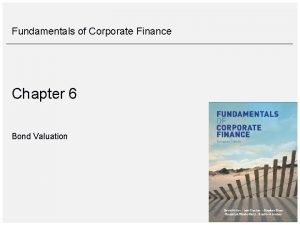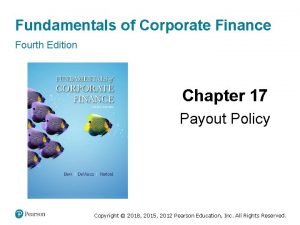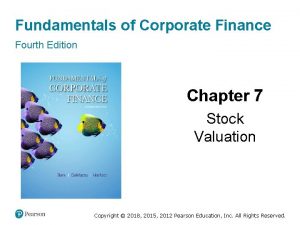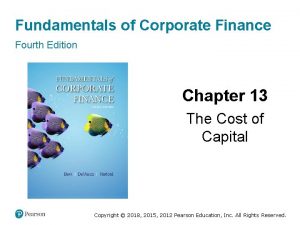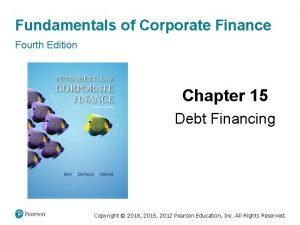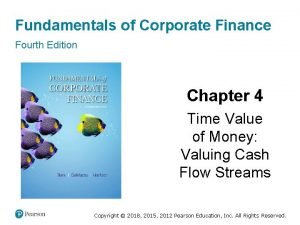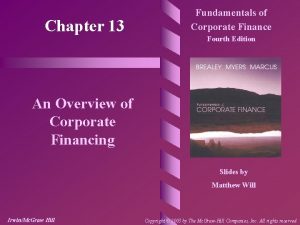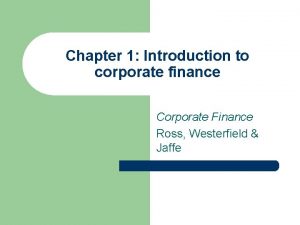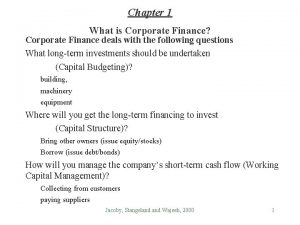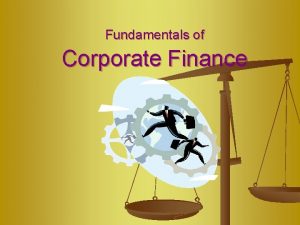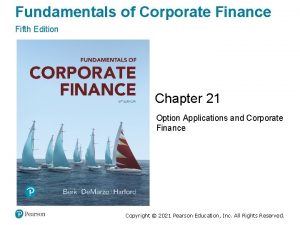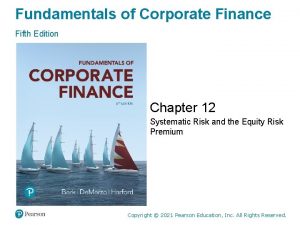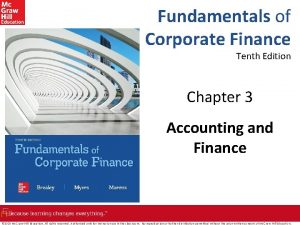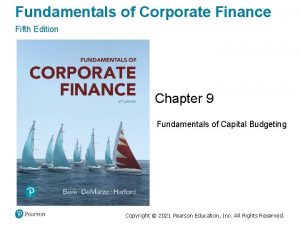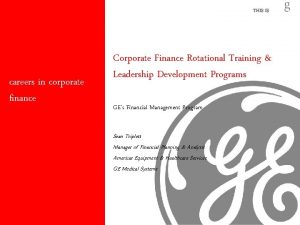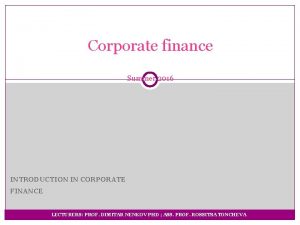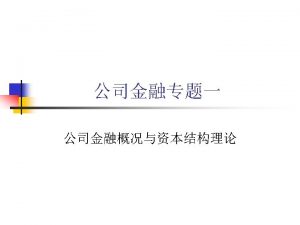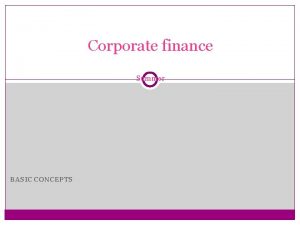Fundamentals of Corporate Finance Fourth Edition Chapter 14



















![Largest Global IPOs (2 of 5) [Table 14. 1 continued] Company Name Industry Underwriter Largest Global IPOs (2 of 5) [Table 14. 1 continued] Company Name Industry Underwriter](https://slidetodoc.com/presentation_image_h/ac508db5210130739ebb2f0c710de831/image-20.jpg)
![Largest Global IPOs (3 of 5) [Table 14. 1 continued] Company Name Offer Date Largest Global IPOs (3 of 5) [Table 14. 1 continued] Company Name Offer Date](https://slidetodoc.com/presentation_image_h/ac508db5210130739ebb2f0c710de831/image-21.jpg)
![Largest Global IPOs (4 of 5) [Table 14. 1 continued] Company Name Offer Date Largest Global IPOs (4 of 5) [Table 14. 1 continued] Company Name Offer Date](https://slidetodoc.com/presentation_image_h/ac508db5210130739ebb2f0c710de831/image-22.jpg)
![Largest Global IPOs (5 of 5) [Table 14. 1 continued] Company Name DDI Corp Largest Global IPOs (5 of 5) [Table 14. 1 continued] Company Name DDI Corp](https://slidetodoc.com/presentation_image_h/ac508db5210130739ebb2f0c710de831/image-23.jpg)



![International IPO Underwriter Ranking Report for 2015 (2 of 3) [Table 14. 2 continued] International IPO Underwriter Ranking Report for 2015 (2 of 3) [Table 14. 2 continued]](https://slidetodoc.com/presentation_image_h/ac508db5210130739ebb2f0c710de831/image-27.jpg)
![International IPO Underwriter Ranking Report for 2015 (3 of 3) [Table 14. 2 continued] International IPO Underwriter Ranking Report for 2015 (3 of 3) [Table 14. 2 continued]](https://slidetodoc.com/presentation_image_h/ac508db5210130739ebb2f0c710de831/image-28.jpg)




































- Slides: 64

Fundamentals of Corporate Finance Fourth Edition Chapter 14 Raising Equity Capital Copyright © 2018, 2015, 2012 Pearson Education, Inc. All Rights Reserved.

14. 1 Equity Financing for Private Companies (1 of 7) • Sources of Funding: – A private company can seek funding from several potential sources: § § Angel Investors Venture Capital Firms Institutional Investors Corporate Investors Copyright © 2018, 2015, 2012 Pearson Education, Inc. All Rights Reserved.

14. 1 Equity Financing for Private Companies (2 of 7) • Angel Investors: – Individual investors who buy equity in small private firms – The first round of outside private equity financing is often obtained from angels Copyright © 2018, 2015, 2012 Pearson Education, Inc. All Rights Reserved.

14. 1 Equity Financing for Private Companies (3 of 7) • Venture Capital Firms: – Specialize in raising money to invest in the private equity of young firms – In return, venture capitalists often demand a great deal of control of the company Copyright © 2018, 2015, 2012 Pearson Education, Inc. All Rights Reserved.

Figure 14. 1 Most Active U. S. Venture Capital Firms in 2015 (by Number of Deals Completed) Source: Venture Pulse, Q 1’ 16, Global Analysis of Venture Funding, KPMG International and CB Insigts April 13, 2016 Copyright © 2018, 2015, 2012 Pearson Education, Inc. All Rights Reserved.

Figure 14. 2 Venture Capital Funding in the United States (1 of 2) Panel (a) indicates the total number of venture capital deals by year. Copyright © 2018, 2015, 2012 Pearson Education, Inc. All Rights Reserved.

Figure 14. 2 Venture Capital Funding in the United States (2 of 2) Panel (b) shows the total dollar amount of venture capital investment. Source: Pw. C/NVCA Money. Tree™ Report, Data: Thomson Reuters, 2016. Copyright © 2018, 2015, 2012 Pearson Education, Inc. All Rights Reserved.

14. 1 Equity Financing for Private Companies (4 of 7) • Institutional Investors: – Pension funds, insurance companies, endowments, and foundations § May invest directly § May invest indirectly by becoming limited partners in venture capital firms Copyright © 2018, 2015, 2012 Pearson Education, Inc. All Rights Reserved.

14. 1 Equity Financing for Private Companies (5 of 7) • Corporate Investors: – Many established corporations purchase equity in younger, private companies § corporate strategic objectives § desire for investment returns – Also called corporate partner, strategic partner, strategic investor Copyright © 2018, 2015, 2012 Pearson Education, Inc. All Rights Reserved.

14. 1 Equity Financing for Private Companies (6 of 7) • Securities and Valuation – When a company decides to sell equity to outside investors for the first time, it is typical to issue preferred stock rather than common stock to raise capital § It is called convertible preferred stock if the owner can convert it into common stock at a future date Copyright © 2018, 2015, 2012 Pearson Education, Inc. All Rights Reserved.

Example 14. 1 Funding and Ownership (1 of 6) Problem: • You founded your own firm two years ago. Initially you contributed $100, 000 of your own money and, in return, received 1. 5 million shares of stock. Since then, you have sold an additional 500, 000 shares to angel investors. Copyright © 2018, 2015, 2012 Pearson Education, Inc. All Rights Reserved.

Example 14. 1 Funding and Ownership (2 of 6) Problem: • Now you are considering raising even more capital from a venture capitalist (VC). This VC would invest $6 million and would receive 3 million newly issued shares. What is the post-money valuation? • Assuming that this is the VC’s first investment in your company, what percentage of the firm will she end up owning? • What percentage will you own? What is the value of your shares? Copyright © 2018, 2015, 2012 Pearson Education, Inc. All Rights Reserved.

Example 14. 1 Funding and Ownership (3 of 6) Solution: Plan: • After this funding round, there will be a total of 5 million shares outstanding: Your shares 1, 500, 000 Angel investors’ shares 500, 000 Newly issued shares 3, 000 Total 5, 000 Copyright © 2018, 2015, 2012 Pearson Education, Inc. All Rights Reserved.

Example 14. 1 Funding and Ownership (4 of 6) Plan: • The VC would be paying • The post-money valuation will be the total number of shares multiplied by the price paid by the VC. The percentage of the firm owned by the VC is the number of her shares divided by the total number of shares. • Your percentage will be the number of your shares divided by the total number of shares, and the value of your shares will be the number of shares you own multiplied by the price the VC paid. Copyright © 2018, 2015, 2012 Pearson Education, Inc. All Rights Reserved.

Example 14. 1 Funding and Ownership (5 of 6) Execute: • There are 5 million shares and the VC paid $2 per share. Therefore, the post-money valuation would be 5, 000 × $2 = $10 million, which, by Equation 14. 1 equals the pre-money valuation ($4 million) plus the amount invested ($6 million). • Because she is buying 3 million shares, and there will be 5 million total shares outstanding after the funding round, the VC will end up owning • You will own and the post-money valuation of your shares is 1, 500, 000 × $2 = $3, 000. Copyright © 2018, 2015, 2012 Pearson Education, Inc. All Rights Reserved.

Example 14. 1 Funding and Ownership (6 of 6) Evaluate: • Funding your firm with new equity capital, whether it is from an angel or a venture capitalist, involves a tradeoff— you must give up part of the ownership of the firm in return for the money you need to grow. • If you can negotiate a higher price per share, the percentage of your firm that you will have to give up for a specified amount of capital will be smaller. Copyright © 2018, 2015, 2012 Pearson Education, Inc. All Rights Reserved.

14. 1 Equity Financing for Private Companies (7 of 7) • Exiting an Investment in a Private Company – Exit Strategy § Acquisition § Public Offering Copyright © 2018, 2015, 2012 Pearson Education, Inc. All Rights Reserved.

14. 2 Taking Your Firm Public: The Initial Public Offering (1 of 7) • The process of selling stock to the public for the first time is called an initial public offering (IPO) Copyright © 2018, 2015, 2012 Pearson Education, Inc. All Rights Reserved.

Largest Global IPOs (1 of 5) Table 14. 1 Largest Global IPOs Company Name Offer Date Exchange Industry Underwriter Deal Size (US $ Millions) Alibaba Group Holding 09/18/2014 NYSE Technology Credit Suisse $21, 767 07/07/2010 Hong Kong / Shanghai Financial Goldman Sachs (Asia) $19, 228 10/20/2006 Hong Kong / Shanghai Financial Merrill Lynch $19, 092 NTT Mobile 10/22/1998 Tokyo Stock Exchange Communications Goldman Sachs (Asia) $18, 099 Visa 03/18/2008 NYSE Financial J. P. Morgan $17, 864 AIA 10/21/2010 Hong Kong Financial Citi $17, 816 ENEL Sp. A 11/01/1999 NYSE Utilities Merrill Lynch $16, 452 ABC Bank ICBC Bank Copyright © 2018, 2015, 2012 Pearson Education, Inc. All Rights Reserved.
![Largest Global IPOs 2 of 5 Table 14 1 continued Company Name Industry Underwriter Largest Global IPOs (2 of 5) [Table 14. 1 continued] Company Name Industry Underwriter](https://slidetodoc.com/presentation_image_h/ac508db5210130739ebb2f0c710de831/image-20.jpg)
Largest Global IPOs (2 of 5) [Table 14. 1 continued] Company Name Industry Underwriter Deal Size (US $ Millions) NASDAQ Technology Morgan Stanley $16, 007 General Motors 11/17/2010 NYSE Capital Goods & Services Morgan Stanley $15, 774 Nippon Tel Tokyo Stock Exchange Communications Nomura Securities $15, 301 Communications Goldman, Sachs & Co $13, 034 Financial Goldman, Sachs & Co $11, 186 Financial Bof. A Merrill Lynch $10, 986 Facebook Deutsche Telekom Bank of China Offer Date 05/17/2012 02/09/1987 Exchange 11/17/1996 NYSE 05/24/2006 Hong Kong/Shanghai Dai-ichi Mutual Life Insurance 03/23/2010 Tokyo Stock Exchange Copyright © 2018, 2015, 2012 Pearson Education, Inc. All Rights Reserved.
![Largest Global IPOs 3 of 5 Table 14 1 continued Company Name Offer Date Largest Global IPOs (3 of 5) [Table 14. 1 continued] Company Name Offer Date](https://slidetodoc.com/presentation_image_h/ac508db5210130739ebb2f0c710de831/image-21.jpg)
Largest Global IPOs (3 of 5) [Table 14. 1 continued] Company Name Offer Date Exchange Industry Underwriter Deal Size (US $ Millions) $10, 620 AT&T Wireless Group 04/26/2000 NYSE Communications Goldman, Sachs & Co. Rosneft Oil Company 07/13/2006 Russian Trading System Energy ABN AMRO $10, 421 05/19/2011 LSE Main/Hong Kong Basic Resources Citi $10, 316 Consumer Nomura Securities $9, 576 $9, 227 $8, 680 Glencore International Japan Tobacco Inc. (JT) 10/27/1994 Tokyo Stock Exchange China Construction Bank 10/20/2005 Hong Kong/Shanghai Financial Morgan Stanley Kraft Foods 06/12/2001 NYSE Consumer Credit Suisse Copyright © 2018, 2015, 2012 Pearson Education, Inc. All Rights Reserved.
![Largest Global IPOs 4 of 5 Table 14 1 continued Company Name Offer Date Largest Global IPOs (4 of 5) [Table 14. 1 continued] Company Name Offer Date](https://slidetodoc.com/presentation_image_h/ac508db5210130739ebb2f0c710de831/image-22.jpg)
Largest Global IPOs (4 of 5) [Table 14. 1 continued] Company Name Offer Date Exchange Industry Underwriter Deal Size (US $ Millions) Electricite De France 11/18/2005 Euronext/Paris Utilities ABN AMRO $8, 328 Water Holding Co 11/22/1989 LSE Main Utilities Credit Suisse $8, 199 VTB Bank 05/10/2007 LSE Main Financial Citi $7, 988 Consumer KPMG Corporate $7, 958 Communications Morgan Stanley $7, 728 Energy Goldman, Sachs & Co. $7, 610 Banader Hotels Co 11/20/2005 Bahrain Stock Exchange Telia AB OMX Nordic Exchange British Gas PLC 06/13/2000 12/08/1986 LSE Main Copyright © 2018, 2015, 2012 Pearson Education, Inc. All Rights Reserved.
![Largest Global IPOs 5 of 5 Table 14 1 continued Company Name DDI Corp Largest Global IPOs (5 of 5) [Table 14. 1 continued] Company Name DDI Corp](https://slidetodoc.com/presentation_image_h/ac508db5210130739ebb2f0c710de831/image-23.jpg)
Largest Global IPOs (5 of 5) [Table 14. 1 continued] Company Name DDI Corp China Engineering France Telecom Banco Santander Brasil Offer Date Exchange 09/03/1993 Tokyo Stock Exchange 07/23/2009 10/17/1997 10/06/2009 Shanghai NYSE/Bovespa Industry Underwriter Deal Size (US $ Millions) Communications Daiwa Securities $7, 592 Capital Goods & Services China International Capital $7, 343 Communications Communicati ons Merrill Lynch $7, 289 Financial Santander Investment $7, 026 Source: www. renaissancecapital. com, June 2016. Copyright © 2018, 2015, 2012 Pearson Education, Inc. All Rights Reserved.

14. 2 Taking Your Firm Public: The Initial Public Offering (2 of 7) • Advantages and Disadvantages of Going Public – Advantages: § Greater liquidity § Better access to capital § Give investors the ability to diversify – Disadvantages: § Equity holders more dispersed § Must satisfy requirements of public companies Copyright © 2018, 2015, 2012 Pearson Education, Inc. All Rights Reserved.

14. 2 Taking Your Firm Public: The Initial Public Offering (3 of 7) • Primary and Secondary IPO Offerings – Primary Offering – Secondary Offering – Underwriters and the Syndicate § Underwriter: an investment banking firm that manages the offering and designs its structure – Lead Underwriter § Syndicate: other underwriters that help market and sell the issue Copyright © 2018, 2015, 2012 Pearson Education, Inc. All Rights Reserved.

International IPO Underwriter Ranking Report for 2015 (1 of 3) Table 14. 2 International IPO Underwriter Ranking Report for 2015 Blank Proceeds (US $ millions) No. of Issues Market Share (Proceeds) Rank for 2015 Rank for 2014 Rank for 2013 Rank for 2012 Morgan Stanley 14, 360. 6 92 7. 6 1 1 3 1 Goldman, Sachs & Co 11, 026. 2 87 5. 9 2 2 1 7 JP Morgan 10, 114. 1 72 5. 4 3 3 2 2 UBS 8, 991. 7 55 4. 8 4 7 8 8 Bank of America Merrill Lynch 8, 610. 2 69 4. 6 5 8 4 4 Citi 8, 134. 0 75 4. 3 6 6 7 5 Deutsche Bank 7, 408. 2 61 3. 9 7 4 5 3 Credit Suisse 5, 670. 3 61 3. 0 8 5 6 6 Copyright © 2018, 2015, 2012 Pearson Education, Inc. All Rights Reserved.
![International IPO Underwriter Ranking Report for 2015 2 of 3 Table 14 2 continued International IPO Underwriter Ranking Report for 2015 (2 of 3) [Table 14. 2 continued]](https://slidetodoc.com/presentation_image_h/ac508db5210130739ebb2f0c710de831/image-27.jpg)
International IPO Underwriter Ranking Report for 2015 (2 of 3) [Table 14. 2 continued] Blank Proceeds (US $ millions) No. of Issues Market Share (Proceeds) Rank for 2015 Rank for 2014 Rank for 2013 Rank for 2012 Barclays 5, 094. 6 43 2. 7 9 9 HSBC Holdings PLC 4, 659. 5 27 2. 5 10 10 14 18 Nomura 3, 516. 9 45 1. 9 11 11 10 15 CITIC 3, 428. 6 23 1. 8 12 16 - - Jefferies LLC 3, 043. 8 43 1. 6 13 14 13 - Sumitomo Mitsui Finl Grp Inc 2, 158. 6 30 1. 2 14 - 19 14 Everbright Securities Co Ltd 2, 075. 3 7 1. 1 15 - - - Daiwa Securities Group Inc 2, 061. 5 18 1. 1 16 - - - Copyright © 2018, 2015, 2012 Pearson Education, Inc. All Rights Reserved.
![International IPO Underwriter Ranking Report for 2015 3 of 3 Table 14 2 continued International IPO Underwriter Ranking Report for 2015 (3 of 3) [Table 14. 2 continued]](https://slidetodoc.com/presentation_image_h/ac508db5210130739ebb2f0c710de831/image-28.jpg)
International IPO Underwriter Ranking Report for 2015 (3 of 3) [Table 14. 2 continued] Blank Proceeds (US $ millions) No. of Issues Market Share (Proceeds) Rank for 2015 Rank for 2014 Rank for 2013 Rank for 2012 Ping An Securities Ltd 2, 028. 0 20 1. 1 17 - - - China International Capital Co 2, 001. 3 18 1. 1 18 - - - Mizuho Financial Group 1, 924. 1 18 1. 0 19 - - 18 China Merchants Securities Co 1, 924. 1 22 1. 0 20 15 - - Source: Thomson. Reuters. Copyright © 2018, 2015, 2012 Pearson Education, Inc. All Rights Reserved.

14. 2 Taking Your Firm Public: The Initial Public Offering (4 of 7) • SEC Filings – Registration Statement § preliminary prospectus or red herring – Final Prospectus Copyright © 2018, 2015, 2012 Pearson Education, Inc. All Rights Reserved.

Figure 14. 3 The Cover Page of Facebook’s IPO Prospectus Source: SEC filings. Copyright © 2018, 2015, 2012 Pearson Education, Inc. All Rights Reserved.

14. 2 Taking Your Firm Public: The Initial Public Offering (5 of 7) • Valuation – Underwriters work with the company to come up with a price range § Estimate the future cash flows and compute the present value § Use market multiples approach – Road Show – Book Building Copyright © 2018, 2015, 2012 Pearson Education, Inc. All Rights Reserved.

Example 14. 2 Valuing an IPO Using Comparables (1 of 7) Problem: • Wagner, Inc. , is a private company that designs, manufactures, and distributes branded consumer products. During its most recent fiscal year, Wagner had revenues of $325 million and earnings of $15 million. Wagner has filed a registration statement with the SEC for its IPO. Copyright © 2018, 2015, 2012 Pearson Education, Inc. All Rights Reserved.

Example 14. 2 Valuing an IPO Using Comparables (2 of 7) Problem: • Before the stock is offered, Wagner’s investment bankers would like to estimate the value of the company using comparable companies. The investment bankers have assembled the following information based on data for other companies in the same industry that have recently gone public. In each case, the ratios are based on the IPO price. Copyright © 2018, 2015, 2012 Pearson Education, Inc. All Rights Reserved.

Example 14. 2 Valuing an IPO Using Comparables (3 of 7) Problem: Company Price/Earnings Price/Revenues Ray Products Corp. 18. 8 × 1. 2 × Byce-Frasier Inc. 19. 5 × 0. 9 × Fashion Industries Group 24. 1 × 0. 8 × Recreation International 22. 4 × 0. 7 × Average 21. 2 × 0. 9 × • After the IPO, Wagner will have 20 million shares outstanding. Estimate the IPO price for Wagner using the price/earnings ratio and the price/revenues ratio. Copyright © 2018, 2015, 2012 Pearson Education, Inc. All Rights Reserved.

Example 14. 2 Valuing an IPO Using Comparables (4 of 7) Solution: Plan: • If the IPO price of Wagner is based on a price/earnings ratio that is similar to those for recent IPOs, then this ratio will equal the average of recent deals. Thus, to compute the IPO price based on the P/E ratio, we will first take the average P/E ratio from the comparison group and multiply it by Wagner’s total earnings. Copyright © 2018, 2015, 2012 Pearson Education, Inc. All Rights Reserved.

Example 14. 2 Valuing an IPO Using Comparables (5 of 7) Solution: Plan: • This will give us a total value of equity for Wagner. To get the per share IPO price, we need to divide the total equity value by the number of shares outstanding after the IPO (20 million). The approach will be the same for the price/revenues ratio. Copyright © 2018, 2015, 2012 Pearson Education, Inc. All Rights Reserved.

Example 14. 2 Valuing an IPO Using Comparables (6 of 7) Execute: • The average P/E ratio for recent deals is 21. 2. Given earnings of $15 million, the total market value of Wagner’s stock will be $15 million × 21. 2 = $318 million. With 20 million shares outstanding, the price per share should be • Similarly, if Wagner’s IPO price implies a price/revenues ratio equal to the recent average of 0. 9, then using its revenues of $325 million, the total market value of Wagner will be $325 million × 0. 9 = $292. 5 million, Copyright © 2018, 2015, 2012 Pearson Education, Inc. All Rights Reserved.

Example 14. 2 Valuing an IPO Using Comparables (7 of 7) Evaluate: • Using multiples for valuation always produces a range of estimates—you should not expect to get the same value from different ratios. Based on these estimates, the underwriters will probably establish an initial price range for Wagner stock of $13 to $17 per share to take on the road show. Copyright © 2018, 2015, 2012 Pearson Education, Inc. All Rights Reserved.

14. 2 Taking Your Firm Public: The Initial Public Offering (6 of 7) • Pricing the Deal and Managing Risk – Firm Commitment IPO: the underwriter guarantees that it will sell all of the stock at the offer price § Spread § Lockup – Over-allotment allocation, or greenshoe provision: allows the underwriter to issue more stock, amounting to 15% of the original offer size, at the IPO offer price Copyright © 2018, 2015, 2012 Pearson Education, Inc. All Rights Reserved.

14. 2 Taking Your Firm Public: The Initial Public Offering (7 of 7) • Other IPO Types – Best-Efforts Basis: the underwriter does not guarantee that the stock will be sold, but instead tries to sell the stock for the best possible price – Auction IPO: The company or its investment bankers auction off the shares, allowing the market to determine the price of the stock Copyright © 2018, 2015, 2012 Pearson Education, Inc. All Rights Reserved.

Bids Received to Purchase Shares in a Hypothetical Auction IPO Table 14. 3 Bids Received to Purchase Shares in a Hypothetical Auction IPO Price Shares Sought at This Price (in thousands) Total Shares Sought at or Above This Price (in thousands) $16. 50 3, 200 11, 800 $17. 00 2, 900 8, 600 $17. 50 2, 700 5, 700 $18. 00 1, 925 3, 000 $18. 50 850 1, 075 $19. 00 150 225 $19. 50 75 75 Copyright © 2018, 2015, 2012 Pearson Education, Inc. All Rights Reserved.

Figure 14. 4 Aggregating the Shares Sought in the Hypothetical Auction IPO Copyright © 2018, 2015, 2012 Pearson Education, Inc. All Rights Reserved.

Example 14. 3 Auction IPO Pricing (1 of 6) Problem: • Fleming Educational Software, Inc. , is selling 500, 000 shares of stock in an auction IPO. At the end of the bidding period, Fleming’s investment bank has received the following bids: Price ($) 8. 00 7. 75 7. 50 7. 25 7. 00 6. 75 6. 50 Number of Shares Bid 25, 000 100, 000 75, 000 150, 000 275, 000 125, 000 • What will the offer price of the shares be? Copyright © 2018, 2015, 2012 Pearson Education, Inc. All Rights Reserved.

Example 14. 3 Auction IPO Pricing (2 of 6) Solution: Plan: • First, we must compute the total number of shares demanded at or above any given price. Then, we pick the highest price that will allow us to sell the full issue (500, 000 shares). Copyright © 2018, 2015, 2012 Pearson Education, Inc. All Rights Reserved.

Example 14. 3 Auction IPO Pricing (3 of 6) Execute: • Converting the table of bids into a table of cumulative demand, we have: Price ($) 8. 00 7. 75 7. 50 7. 25 7. 00 6. 75 6. 50 Cumulative Demand 25, 000 125, 000 200, 000 350, 000 500, 000 775, 000 900, 000 • For example, the company has received bids for a total of 125, 000 shares at $7. 75 per share or higher 125, 000 + 100, 000 = 125, 0002. Copyright © 2018, 2015, 2012 Pearson Education, Inc. All Rights Reserved.

Example 14. 3 Auction IPO Pricing (4 of 6) Execute: • Fleming is offering a total of 500, 000 shares. The winning auction price would be $7 per share, because investors have placed orders for a total of 500, 000 shares at a price of $7 or higher. • All investors who placed bids of at least this price will be able to buy the stock for $7 per share, even if their initial bid was higher. Copyright © 2018, 2015, 2012 Pearson Education, Inc. All Rights Reserved.

Example 14. 3 Auction IPO Pricing (5 of 6) Execute: • In this example, the cumulative demand at the winning price exactly equals the supply. If the total demand at this price were greater than the supply, all auction participants who bid prices higher than the winning price would receive their full bid (at the winning price). • Shares would be awarded on a pro rata basis to bidders who bid exactly the winning price. Copyright © 2018, 2015, 2012 Pearson Education, Inc. All Rights Reserved.

Example 14. 3 Auction IPO Pricing (6 of 6) Evaluate: • Although the auction IPO does not provide the certainty of the firm commitment, it has the advantage of using the market to determine the offer price. • It also reduces the underwriter’s role and, consequently, fees. Copyright © 2018, 2015, 2012 Pearson Education, Inc. All Rights Reserved.

Summary of IPO Methods Table 14. 4 Summary of IPO Methods Firm Commitment Best-Efforts Basis Auction IPO Underwriter purchases the entire issue at an agreed price and sells it to investors at a higher price. Underwriter makes its “best effort” to sell the issue to investors at an agreed price. Firm or underwriter solicits bids (price and quantity) from investors, and chooses the highest price at which there is sufficient demand to sell the entire issue. Copyright © 2018, 2015, 2012 Pearson Education, Inc. All Rights Reserved.

14. 3 IPO Puzzles (1 of 5) • Four IPO puzzles: – – Underpricing of IPOs “Hot” and “cold” IPO markets High costs of issuing an IPO Poor post-IPO long-run stock performance Copyright © 2018, 2015, 2012 Pearson Education, Inc. All Rights Reserved.

14. 3 IPO Puzzles (2 of 5) • Underpriced IPOs – On average, between 1960 and 2016, the price in the U. S. aftermarket was 17% higher at the end of the first day of trading § Who wins and who loses because of underpricing? Copyright © 2018, 2015, 2012 Pearson Education, Inc. All Rights Reserved.

Figure 14. 5 International Comparison of First-Day IPO Returns Source: Adapted courtesy of Jay Ritter (https: //site. warrington. ufl. edu/ritter/ipo-data/). Copyright © 2018, 2015, 2012 Pearson Education, Inc. All Rights Reserved.

14. 3 IPO Puzzles (3 of 5) • “Hot” and “Cold” IPO Markets – It appears that the number of IPOs is not solely driven by the demand for capital – Sometimes firms and investors seem to favor IPOs; at other times firms appear to rely on alternative sources of capital Copyright © 2018, 2015, 2012 Pearson Education, Inc. All Rights Reserved.

Figure 14. 6 Cyclicality of Initial Public Offerings in the United States, (1975 -2015) Source: Adapted courtesy of Jay R. Ritter (https: //site. warrington. ufl. edu/ritter/ipo-data/). Copyright © 2018, 2015, 2012 Pearson Education, Inc. All Rights Reserved.

14. 3 IPO Puzzles (4 of 5) • High Cost of Issuing an IPO – In the U. S. , the discount below the issue price at which the underwriter purchases the shares from the issuing firm is 7% of the issue price – This fee is large, especially considering the additional cost to the firm associated with underpricing Copyright © 2018, 2015, 2012 Pearson Education, Inc. All Rights Reserved.

Figure 14. 7 Relative Costs of Issuing Securities Source: Adapted from I. Lee, S. Lochhead, J. Ritter, and Q. Zhao, “The Costs of Raising Capital, ” Journal of Financial Research, 19 (1) (1996): 59– 74. Copyright © 2018, 2015, 2012 Pearson Education, Inc. All Rights Reserved.

14. 3 IPO Puzzles (5 of 5) • Poor Post-IPO Long-Run Stock Performance – Newly listed firms appear to perform relatively poorly over the following three to five years after their IPOs – That underperformance might not result from the issue of equity itself, but rather from the conditions that motivated the equity issuance in the first place Copyright © 2018, 2015, 2012 Pearson Education, Inc. All Rights Reserved.

14. 4 Raising Additional Capital: The Seasoned Equity Offering (1 of 5) • A firm’s need for outside capital rarely ends at the IPO – Seasoned Equity Offering (SEO): firms return to the equity markets and offer new shares for sale Copyright © 2018, 2015, 2012 Pearson Education, Inc. All Rights Reserved.

14. 4 Raising Additional Capital: The Seasoned Equity Offering (2 of 5) • SEO Process – When a firm issues stock using an SEO, it follows many of the same steps as for an IPO – Main difference is that the price-setting process is not necessary § Tombstones Copyright © 2018, 2015, 2012 Pearson Education, Inc. All Rights Reserved.

Figure 14. 8 Prospectus for the Facebook SEO Source: SEC Filings. Copyright © 2018, 2015, 2012 Pearson Education, Inc. All Rights Reserved.

14. 4 Raising Additional Capital: The Seasoned Equity Offering (3 of 5) • Two kinds of seasoned equity offerings: – Cash offer – Rights offer Copyright © 2018, 2015, 2012 Pearson Education, Inc. All Rights Reserved.

14. 4 Raising Additional Capital: The Seasoned Equity Offering (4 of 5) • Researchers have found that, on average, the market greets the news of an SEO with a price decline (about 1. 5%) – Often the value lost can be a significant fraction of the new money raised – Adverse selection (the lemons problem) Copyright © 2018, 2015, 2012 Pearson Education, Inc. All Rights Reserved.

Figure 14. 9 Price Reaction to an SEO Announcement Source: CRSP and authors’ calculations. Copyright © 2018, 2015, 2012 Pearson Education, Inc. All Rights Reserved.

14. 4 Raising Additional Capital: The Seasoned Equity Offering (5 of 5) • SEO Costs – In addition to the price drop when the SEO is announced, the firm must pay direct costs as well. Underwriting fees amount to 5% of the proceeds of the issue Copyright © 2018, 2015, 2012 Pearson Education, Inc. All Rights Reserved.
 Fundamentals of corporate finance, third canadian edition
Fundamentals of corporate finance, third canadian edition Fundamentals of corporate finance third canadian edition
Fundamentals of corporate finance third canadian edition Fundamentals of corporate finance fifth edition
Fundamentals of corporate finance fifth edition Corporate finance 6th edition
Corporate finance 6th edition Fundamentals of corporate finance chapter 6 solutions
Fundamentals of corporate finance chapter 6 solutions Fundamentals of corporate finance (doc or html) file
Fundamentals of corporate finance (doc or html) file Fundamentals of corporate finance, chapter 1
Fundamentals of corporate finance, chapter 1 Objectives of corporate finance
Objectives of corporate finance Corporate finance tenth edition
Corporate finance tenth edition Corporate finance tenth edition
Corporate finance tenth edition Corporate finance tenth edition
Corporate finance tenth edition Corporate finance tenth edition
Corporate finance tenth edition Corporate finance tenth edition
Corporate finance tenth edition Project 2 fourth edition
Project 2 fourth edition Pathways algebra 2
Pathways algebra 2 Ethics in information technology fourth edition
Ethics in information technology fourth edition Ethics in information technology 6th edition answers
Ethics in information technology 6th edition answers Project 4 fourth edition
Project 4 fourth edition Discrete mathematics with applications fourth edition
Discrete mathematics with applications fourth edition Expert systems: principles and programming, fourth edition
Expert systems: principles and programming, fourth edition Introduction to corporate finance
Introduction to corporate finance Principles of corporate finance chapter 3 solutions
Principles of corporate finance chapter 3 solutions Corporate finance chapter 1
Corporate finance chapter 1 Chapter 1 introduction to corporate finance
Chapter 1 introduction to corporate finance Chapter 1 introduction to corporate finance
Chapter 1 introduction to corporate finance Finance fundamentals for nonprofits
Finance fundamentals for nonprofits Real estate finance fundamentals
Real estate finance fundamentals Fundamentals of information systems 9th edition
Fundamentals of information systems 9th edition Fundamentals of information systems 9th edition
Fundamentals of information systems 9th edition No slip condition
No slip condition Digital fundamentals tenth edition floyd
Digital fundamentals tenth edition floyd Machining fundamentals 10th edition
Machining fundamentals 10th edition Fundamentals of organizational communication 9th edition
Fundamentals of organizational communication 9th edition Fundamentals of organizational communication 9th edition
Fundamentals of organizational communication 9th edition Floyd digital fundamentals ppt
Floyd digital fundamentals ppt Floyd digital fundamentals 10th edition pdf
Floyd digital fundamentals 10th edition pdf Dc/ac fundamentals a systems approach
Dc/ac fundamentals a systems approach Computer security fundamentals 4th edition
Computer security fundamentals 4th edition Management fundamentals 8th edition
Management fundamentals 8th edition Fundamentals of information systems 9th edition
Fundamentals of information systems 9th edition Fundamentals of abnormal psychology ninth edition
Fundamentals of abnormal psychology ninth edition Fundamentals of information systems 9th edition
Fundamentals of information systems 9th edition Fundamentals of heat and mass transfer 4th edition
Fundamentals of heat and mass transfer 4th edition The fundamentals of political science research 2nd edition
The fundamentals of political science research 2nd edition Modern financial theory
Modern financial theory Tom sanzillo
Tom sanzillo Corporate finance vs investment banking
Corporate finance vs investment banking Corporate finance job scope
Corporate finance job scope Objective of corporate finance
Objective of corporate finance Objectives of corporate finance
Objectives of corporate finance Objective of corporate finance
Objective of corporate finance Maastricht university ib
Maastricht university ib Contemporary corporate finance
Contemporary corporate finance Scope of corporate finance
Scope of corporate finance Objective of corporate finance
Objective of corporate finance Introduction to corporate finance quiz
Introduction to corporate finance quiz Charlton law firm
Charlton law firm Corporate finance syllabus
Corporate finance syllabus Foundations of corporate finance
Foundations of corporate finance Gbs electives
Gbs electives Ethics in corporate finance
Ethics in corporate finance Corporate finance overview
Corporate finance overview Conservation of corporate finance
Conservation of corporate finance Corporate finance bonds
Corporate finance bonds Principles of corporate finance
Principles of corporate finance






